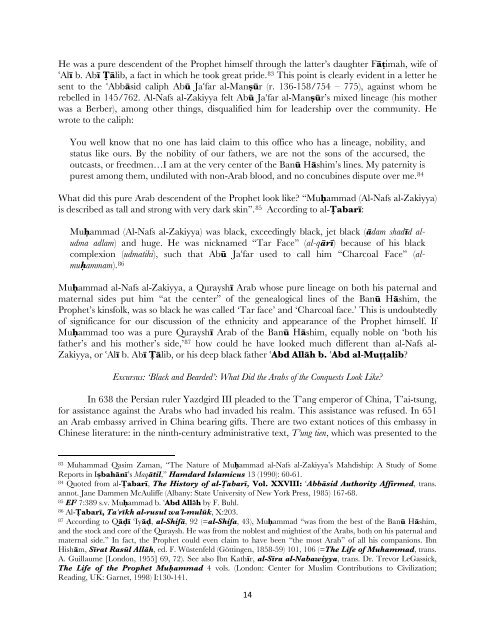“Anyone who says that the Prophet is black should be killed”: The ...
“Anyone who says that the Prophet is black should be killed”: The ...
“Anyone who says that the Prophet is black should be killed”: The ...
Create successful ePaper yourself
Turn your PDF publications into a flip-book with our unique Google optimized e-Paper software.
He was a pure descendent of <strong>the</strong> <strong>Prophet</strong> himself through <strong>the</strong> latter’s daughter F§ãimah, wife of<br />
#AlÊ b. AbÊ •§lib, a fact in which he took great pride. 83 Th<strong>is</strong> point <strong>is</strong> clearly evident in a letter he<br />
sent to <strong>the</strong> #Abb§sid caliph Abå Ja#far al-Manßår (r. 136-158/754 – 775), against <strong>who</strong>m he<br />
re<strong>be</strong>lled in 145/762. Al-Nafs al-Zakiyya felt Abå Ja#far al-Manßår’s mixed lineage (h<strong>is</strong> mo<strong>the</strong>r<br />
was a Ber<strong>be</strong>r), among o<strong>the</strong>r things, d<strong>is</strong>qualified him for leadership over <strong>the</strong> community. He<br />
wrote to <strong>the</strong> caliph:<br />
You well know <strong>that</strong> no one has laid claim to th<strong>is</strong> office <strong>who</strong> has a lineage, nobility, and<br />
status like ours. By <strong>the</strong> nobility of our fa<strong>the</strong>rs, we are not <strong>the</strong> sons of <strong>the</strong> accursed, <strong>the</strong><br />
outcasts, or freedmen…I am at <strong>the</strong> very center of <strong>the</strong> Banå H§shim’s lines. My paternity <strong>is</strong><br />
purest among <strong>the</strong>m, undiluted with non-Arab blood, and no concubines d<strong>is</strong>pute over me. 84<br />
What did th<strong>is</strong> pure Arab descendent of <strong>the</strong> <strong>Prophet</strong> look like? “MuÈammad (Al-Nafs al-Zakiyya)<br />
<strong>is</strong> descri<strong>be</strong>d as tall and strong with very dark skin”. 85 According to al-•abarÊ:<br />
MuÈammad (Al-Nafs al-Zakiyya) was <strong>black</strong>, exceedingly <strong>black</strong>, jet <strong>black</strong> (§dam shadÊd aludma<br />
adlam) and huge. He was nicknamed “Tar Face” (al-q§rÊ) <strong>be</strong>cause of h<strong>is</strong> <strong>black</strong><br />
complexion (udmatihi), such <strong>that</strong> Abå Ja#far used to call him “Charcoal Face” (almuÈammam).<br />
86<br />
MuÈammad al-Nafs al-Zakiyya, a QurayshÊ Arab <strong>who</strong>se pure lineage on both h<strong>is</strong> paternal and<br />
maternal sides put him “at <strong>the</strong> center” of <strong>the</strong> genealogical lines of <strong>the</strong> Banå H§shim, <strong>the</strong><br />
<strong>Prophet</strong>’s kinsfolk, was so <strong>black</strong> he was called ‘Tar face’ and ‘Charcoal face.’ Th<strong>is</strong> <strong>is</strong> undoubtedly<br />
of significance for our d<strong>is</strong>cussion of <strong>the</strong> ethnicity and appearance of <strong>the</strong> <strong>Prophet</strong> himself. If<br />
MuÈammad too was a pure QurayshÊ Arab of <strong>the</strong> Banå H§shim, equally noble on ‘both h<strong>is</strong><br />
fa<strong>the</strong>r’s and h<strong>is</strong> mo<strong>the</strong>r’s side,’ 87 how could he have looked much different than al-Nafs al-<br />
Zakiyya, or #AlÊ b. AbÊ •§lib, or h<strong>is</strong> deep <strong>black</strong> fa<strong>the</strong>r #Abd All§h b. #Abd al-Muããalib?<br />
Excursus: ‘Black and Bearded’: What Did <strong>the</strong> Arabs of <strong>the</strong> Conquests Look Like?<br />
In 638 <strong>the</strong> Persian ruler Yazdgird III pleaded to <strong>the</strong> T’ang emperor of China, T’ai-tsung,<br />
for ass<strong>is</strong>tance against <strong>the</strong> Arabs <strong>who</strong> had invaded h<strong>is</strong> realm. Th<strong>is</strong> ass<strong>is</strong>tance was refused. In 651<br />
an Arab embassy arrived in China <strong>be</strong>aring gifts. <strong>The</strong>re are two extant notices of th<strong>is</strong> embassy in<br />
Chinese literature: in <strong>the</strong> ninth-century admin<strong>is</strong>trative text, T’ung tien, which was presented to <strong>the</strong><br />
83 Muhammad Qasim Zaman, “<strong>The</strong> Nature of MuÈammad al-Nafs al-Zakiyya’s Mahd<strong>is</strong>hip: A Study of Some<br />
Reports in Ißbah§nÊ’s Maq§til,” Hamdard Islamicus 13 (1990): 60-61.<br />
84 Quoted from al-•abarÊ, <strong>The</strong> H<strong>is</strong>tory of al-•abarÊ, Vol. XXVIII: #Abb§sid Authority Affirmed, trans.<br />
annot. Jane Dammen McAuliffe (Albany: State University of New York Press, 1985) 167-68.<br />
85 EI 2 7:389 s.v. MuÈammad b. #Abd Allāh by F. Buhl.<br />
86 Al-•abarÊ, Ta"rÊkh al-rusul wa"l-mulåk, X:203.<br />
87 According to Q§∙Ê #Iy§∙, al-Shif§, 92 (=al-Shifa, 43), MuÈammad “was from <strong>the</strong> <strong>be</strong>st of <strong>the</strong> Banå H§shim,<br />
and <strong>the</strong> stock and core of <strong>the</strong> Quraysh. He was from <strong>the</strong> noblest and mightiest of <strong>the</strong> Arabs, both on h<strong>is</strong> paternal and<br />
maternal side.” In fact, <strong>the</strong> <strong>Prophet</strong> could even claim to have <strong>be</strong>en “<strong>the</strong> most Arab” of all h<strong>is</strong> companions. Ibn<br />
H<strong>is</strong>h§m, SÊrat Rasål All§h, ed. F. Wüstenfeld (Göttingen, 1858-59) 101, 106 (=<strong>The</strong> Life of Muhammad, trans.<br />
A. Guillaume [London, 1955] 69, 72). See also Ibn KathÊr, al-SÊra al-Nabawiyya, trans. Dr. Trevor LeGassick,<br />
<strong>The</strong> Life of <strong>the</strong> <strong>Prophet</strong> MuÈammad 4 vols. (London: Center for Muslim Contributions to Civilization;<br />
Reading, UK: Garnet, 1998) I:130-141.<br />
14
















